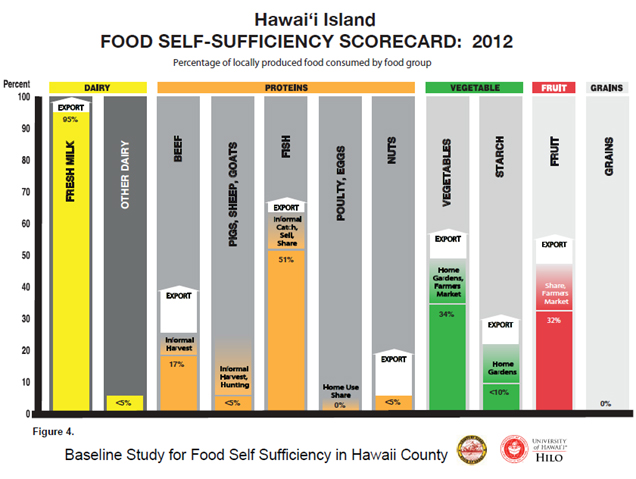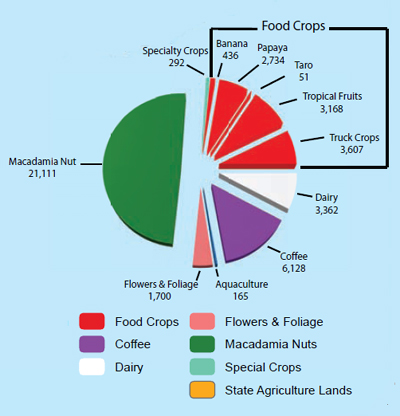HILO, Hawaii: Hawaii County now has a greater understanding of how agriculture and eating habits on the Big Island relate to the quest for self-sufficiency.
On Thursday, local media joined Mayor Billy Kenoi and other officials on the balcony of the mayor’s office in Hilo, where the Hawaii County Food Self-Sufficiency Baseline was released and explained.
The baseline study was prepared for the County Department of Research and Development by the University of Hawaii at Hilo Geography and Environmental Studies Department and Island Planning. The principal authors were Jeffrey Melrose and Dr. Donna Delparte.
The cornerstone graphic of the presentation and the study was the Food Self-Sufficiency Scorecard, which is further explained below in a county media release:
Hawaiʻi County Food Self Sufficiency Scorecard
The above scorecard graphic summarizes the current state of local food production by major food groupings:
- Roughly 95% of all fresh milk sold on Hawaiʻi Island comes from the two local dairies. All raw Hawaiʻi Island milk is sold to Meadow Gold and is packaged at their Railroad Ave. plant for multiple brands including Mountain Apple, Lucerne, Best Yet and others. No organic milk is produced on the island and only a small portion of other dairy products, primarily half and half comes from local sources. A portion of locally produced fresh milk is shipped to other islands for retail sales and bulk processing in Honolulu.
- 17% of the fresh beef sold commercially on the island comes from local ranchers. Hawaiʻi Island ranchers produce roughly twice the number of cattle needed to feed the island’s population but most are shipped to the mainland for fattening and market. Additionally some of Hawaiʻi Island’s beef is shipped to Oahu as hamburger and specialty cuts of grass fed beef.
- Less than 5% of the pork and none of the chick or eggs consumed on the island come from local commercial sources. Informal sources of local eggs are available in neighborhoods and at Farmers Markets. Wild pigs and other game animals account for an estimated 400,000 pounds of meat annually in the informal food supply.
- Macadamia nuts represent roughly 5% of the total nut protein consumed on island. The Island produce more than 6 times the total average annual demand for this protein source but macadamia is just a small portion of our local nut consumption.
- 51% of the fish purchased commercially in the State of Hawaiʻi comes from Hawaiian waters. This number comes from a 2012 CTAHR study that counted commercial and recreation catch numbers statewide. Under reporting and non reported recreational fishing may increase this number on Hawaiʻi Island. Some fish is exported to HNL and other markets as well.
- Base on 2008 numbers, when the State stopped collecting most agricultural statistics, 34% of the State’s vegetables and 32% of its fruits consumption is produced locally. Hawaiʻi Island also exports much of its fruit production and significant amounts of its vegetable and sweet potato production within the state and internationally. There are significant amounts of both vegetables and fruits that are sold at Farmers Markets and other outlets that are no accounted for in these numbers.
- Locally produced vegetable starches like taro, sweet potato, cassava and other crops amount to less than 10% of total starch consumption. Nearly 12 million pounds of sweet potato are exported to the West Coast annually
- None of Hawaiʻi’s grain consumption is produced locally.
- There is also a significant amount of consumption that comes from informal sources that cannot be tracked. Farmers Markets, neighborhood sharing, back yard farming and ranching, recreational fishing and hunting all contribute an immeasurable amount of food to local families and are reflected in the scorecard as additional production that exceeds available statistics.
The press release also contained information on the island’s crop lands, and how they are used.
Crop Land Summary
The Baseline study provides detailed maps of the existing agricultural activity in each region on Hawaiʻi Island.
- In aggregate, there are approximately 42,700 acres in crop production (excluding commercial forestry), half of which is in macadamia nuts, the bulk of which is exported. Only about 10,400 acres (24%) are in vegetable and fruit production and a significant portion of this production (papaya, tropical fruit, sweet potato and vegetables etc.) is grown for export elsewhere.
- Pasture takes up roughly 600,000 acres on the island with productivity that varies by rainfall, location, management techniques etc. Building a grass fed beef industry to support local beef and other meat producers will require improvements to local slaughter facilities, committed local ranchers and strong support from consumers to select local grass fed beef at a price that can sustain its production.
- Crop production varies from region to region and each district has its own set of unique forces and resources that help to define the kinds of agricultural production that takes place in each area. The report provides a summary of regional production and discusses the context in which that production takes place and the contribution each area can make in terms of future food self sufficiency.
County Real Property Taxes
The report provides several maps and supporting data to summarize the state of current agriculture based on the real property tax records for Agricultural Use and Dedication Programs. These programs effect over 600,000 acres island-wide and result in $34 million dollars in tax saving to landowners. Real Property Tax benefits for agricultural use is the single largest tool the county has to encourage local food production and the current system could be more clearly focused to accomplish that goal.Irrigation Systems
The current state of the five dedicated agricultural water systems on the island is summarized in the report along with a map of properties that draw agricultural water from the domestic system operated by the County Department of Water Supply. DWS is currently the largest daily provider of irrigation water islandwide serving a disperse group of farm activities. The largest single user of irrigation water on the island is the Natural Energy Laboratory at Keahole Point who provides fresh water to multiple aquacultural businesses.Ocean Resources, Subsistence Hunting and Honey Bees
The report summarizes useful data related to ocean resource management and emphasizes the need for local actions to insure cooperative management for sustained use of the ocean commons that surround the island. It also summarizes available hunting data and tries to define the volume of meat taken from the forest and mauka lands to support the food needs of local families. The role of commercial honey bees is discussed and their importance in the food system is also discussed.
In this special video segment, we bring you the a portion of the presentation made at the press conference by Melrose.
After the presentation, Mayor Kenoi praised the work that went into the baseline study, and the valuable information that is now at the county’s disposal.



by Big Island Video News1:14 pm
on at
STORY SUMMARY
Hawaii County now has a greater understanding of how agriculture and eating habits on the Big Island relate to the quest for self-sufficiency.